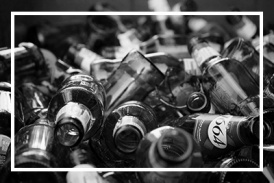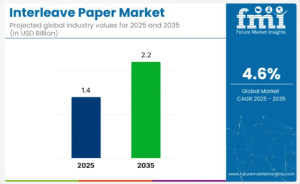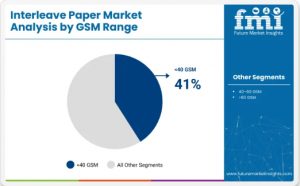Interleave Paper Evolves with Food Safety, Automation, and Anti-Static Tech in Global Industrial Packaging Systems
From food to metals and electronics, interleave paper adapts to automation, surface protection, and regulatory shifts with thinner, safer, and tailored formats.
NEWARK, DE, UNITED STATES, August 6, 2025 /EINPresswire.com/ -- The global interleave paper market is forecast to grow from USD 1.4 billion in 2025 to USD 2.2 billion by 2035, reflecting a Compound Annual Growth Rate (CAGR) of 4.6%. This growth is a result of rising demand for interleave paper's crucial role in protecting products from abrasion, scratches, and contamination across key sectors such as food, electronics, and automotive.
As industries increasingly adopt high-speed automation and face regulatory pressure to reduce plastic usage, interleave paper is gaining traction as a biodegradable and recyclable material. Its specialized function in separating and protecting products in transit and storage is making it a vital component of modern packaging strategies.
Key Market Segments Defining Industry Trajectory
Several key segments are driving market investment and product development:
- Lightweight Variants (<40 GSM) Lead in Volume: Papers with a grammage below 40 GSM are projected to account for a 41% share of the global market in 2025. These lightweight variants are favored for their compatibility with high-speed automated lamination, wrapping, and separation systems, particularly in high-volume food processing and electronics manufacturing.
- Waxed Paper Dominates Material Demand: Waxed paper is expected to represent 44% of interleave material consumption. Its popularity stems from its superior barrier properties, including moisture and grease resistance and temperature stability, making it an ideal choice for food packaging (e.g., meat and frozen goods) and for protecting mechanical and electronic components.
- Surface Protection is the Primary Application: Surface protection commands a 58% share of applications. This demand is driven by the need to safeguard sensitive surfaces—such as polished metals, precision optics, and coated sheets—from scratches, dust, and pressure marks during handling and transit.
- Metal & Glass Industries Are Largest End-Users: The metal and glass industry is the largest end-use sector, accounting for 47% of consumption. These industries rely on interleave paper for layering polished steel, mirror-finished glass, and other delicate surfaces to prevent damage during processing, storage, and shipment.
Innovation and Market Dynamics
The interleave paper market is characterized by a focus on performance-driven innovation. Suppliers are developing new coated variants and customized formats to meet evolving industry standards. Recent product advancements include Ahlstrom's dual-layer waxed sheets for chilled bakery applications, Nissho Iwai Paper's anti-static papers for optical interleaving, and PacPro Inc.'s pre-sized interleaves for robotic systems.
However, the industry also faces challenges such as thickness variation and humidity-induced warping, which can impact quality and automation efficiency. Manufacturers are continuously working to refine production processes to ensure consistency and reliability.
Global Growth Outlook
The interleave paper market is experiencing divergent growth rates across key regions:
- India Leads with a 4.8% CAGR: India is the fastest-growing market among profiled countries, driven by its expanding processed food sector, burgeoning electronics industry, and rising demand for protective packaging for automotive sheets.
- Strong Growth in the United States and Germany: The United States (4.3% CAGR) is driven by the use of FDA-compliant materials in meat processing and demand for scratch-free shipping in optics and steel. Germany (4.2% CAGR) shows firm demand from its automotive and industrial sectors, with growth aligned with REACH-driven material compliance.
- Moderate Growth in China and Canada: The Chinese market is forecast to grow at 3.7% CAGR, supported by the packaging of smartphone components and cross-border e-commerce. Canada (3.4% CAGR) sees growth concentrated in food, pharmaceutical, and metal sheet dispatch applications, influenced by strict food safety regulations.
Request Interleave Paper Market Draft Report: https://www.futuremarketinsights.com/reports/sample/rep-gb-22403
For more on their methodology and market coverage, visit! https://www.futuremarketinsights.com/about-us
Competitive Landscape & Key News
The market is led by established players like Ahlstrom, which holds a 31% industry share, along with Xamax Industries and Twin Rivers Paper Company. Recent industry news highlights a trend toward consolidation and technological advancement:
- International Paper's Acquisition: In January 2025, International Paper secured EU approval to acquire DS Smith for USD 7.2 billion, a move that will expand its footprint in specialty and protective paper substrates across Europe.
- Evonik's New Primer: In May 2025, Evonik unveiled a new dispersion series designed to enhance ink adhesion on coated interleave sheets, improving performance for food and electronics applications.
These developments signal a dynamic and competitive market where innovation in materials science and strategic expansion will be key to meeting the demands of a globalized and increasingly automated supply chain.
Related Reports:
Paper Bags Market: https://www.futuremarketinsights.com/reports/paper-bags-market
Paperboard Packaging Market: https://www.futuremarketinsights.com/reports/paperboard-packaging-market
Paper Waste Strippers Market: https://www.futuremarketinsights.com/reports/paper-waste-strippers-market
Editor’s Note:
This release is based exclusively on verified and factual market content derived from industry analysis by Future Market Insights. No AI-generated statistics or speculative data have been introduced. This press release highlights significant shifts in the Interleave Paper Market, which is experiencing a pivotal change driven by consumer demand for healthier, more transparent products.
Rahul Singh
Future Market Insights Inc.
+18455795705 ext.
email us here
Visit us on social media:
Other
Legal Disclaimer:
EIN Presswire provides this news content "as is" without warranty of any kind. We do not accept any responsibility or liability for the accuracy, content, images, videos, licenses, completeness, legality, or reliability of the information contained in this article. If you have any complaints or copyright issues related to this article, kindly contact the author above.
THE WEATHER CHANNEL ANNOUNCES DEBUT OF "KATRINA 20"; A COMMEMORATIVE LOOK BACK AT HURRICANE KATRINA'S DEVASTATING IMPACT
Redefining Financial Reporting: Chartered Institute Launches CIFRS™ Certification for Financial and Accounting Leaders
DAM Fashion by Deborah Ann Mack Announces Re-Grand Opening and Fall 2025 Coat Preview
Więcej ważnych informacji
 Jedynka Newserii
Jedynka Newserii

 Jedynka Newserii
Jedynka Newserii

Handel

1 października ruszy w Polsce system kaucyjny. Część sieci handlowych może nie zdążyć z przygotowaniami przed tym terminem
Producenci, sklepy i operatorzy systemu kaucyjnego mają niespełna dwa miesiące na finalizację przygotowań do jego startu. Wówczas na rynku pojawią się napoje w specjalnie oznakowanych opakowaniach, a jednostki handlu powinny być gotowe na ich odbieranie. Część z nich jest już do tego przygotowana, część ostrzega przed ewentualnymi opóźnieniami. Jednym z ważniejszych aspektów przygotowań na te dwa miesiące jest uregulowanie współpracy między operatorami, których będzie siedmiu, co oznacza de facto siedem różnych systemów kaucyjnych.
Ochrona środowiska
KE proponuje nowy cel klimatyczny. Według europosłów wydaje się niemożliwy do realizacji

Komisja Europejska zaproponowała zmianę unijnego prawa o klimacie, wskazując nowy cel klimatyczny na 2040 roku, czyli redukcję emisji gazów cieplarnianych o 90 proc. w porównaniu do 1990 rok. Jesienią odniosą się do tego kraje członkowskie i Parlament Europejski, ale już dziś słychać wiele negatywnych głosów. Zdaniem polskich europarlamentarzystów już dotychczas ustanowione cele nie zostaną osiągnięte, a europejska gospodarka i jej konkurencyjność ucierpi na dążeniu do ich realizacji względem m.in. Stanów Zjednoczonych czy Chin.
Handel
Amerykańskie indeksy mają za sobą kolejny wzrostowy miesiąc. Druga połowa roku na rynkach akcji może być nerwowa

Lipiec zazwyczaj jest pozytywnym miesiącem na rynkach akcji i tegoroczny nie był wyjątkiem. Amerykańskie indeksy zakończyły go na plusie, podobnie jak większość europejskich. Rynki Starego Kontynentu nie przyciągają jednak już kapitału z taką intensywnością jak w pierwszej części roku. Z drugiej strony wyceny za oceanem po kolejnych rekordach są już bardzo wysokie, a wpływ nowego porządku celnego narzuconego przez Donalda Trumpa – na razie trudny do przewidzenia. W najbliższym czasie na rynkach można się spodziewać jeszcze większej zmienności i nerwowości, ale dopóki spółki pokazują dobre wyniki, przesłanek do zmiany trendu na spadkowy nie ma.
Partner serwisu
Szkolenia

Akademia Newserii
Akademia Newserii to projekt, w ramach którego najlepsi polscy dziennikarze biznesowi, giełdowi oraz lifestylowi, a także szkoleniowcy z wieloletnim doświadczeniem dzielą się swoją wiedzą nt. pracy z mediami.




![Nestlé w Polsce podsumowuje wpływ na krajową gospodarkę. Firma wygenerowała 0,6 proc. polskiego PKB [DEPESZA]](https://www.newseria.pl/files/1097841585/fabryka-nesquik_1,w_85,r_png,_small.png)




.gif)

 |
| |
| |
|